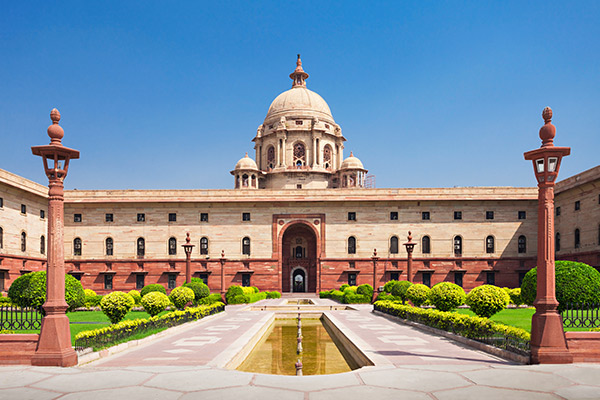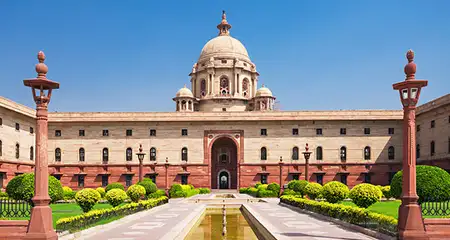The Rashtrapati Bhavan in New Delhi is the official residence of the Honorable President of India. Also known as the President House or Presidential Residence, this building is among the grandest and largest residences designed for a Head of State around the world. A huge mansion in itself, this imposing building and the sprawling lawns surrounding it make for a prime tourist attraction in New Delhi. So how about visiting the presidential mansion of the world’s largest democracy once you step out of your hotels in Delhi for a sightseeing tour?
In this blog, we bring to you all the details you need to know about the Rashtrapati Bhavan in New Delhi, including its history, architecture, timings, entry fee, visitor information, and other interesting facts.
Rashtrapati Bhavan: Information
| Location | Rajpath, New Delhi |
| Type | Official Residence |
| Also Known as | President House, Presidential Residence |
| Formerly Known as | Viceroy’s House |
| Timings | 9:00 am to 4:00 pm; prior permission and booking required |
| Entry Fee | ₹50 per person per circuit (for individuals or a group of fewer than 30 people) |
| ₹1200 per person (for a group of 30 people) | |
| ₹1200 per person + ₹50 per additional visitor (for a group of more than 30 people) | |
| No charges for visitors below 8 years of age | |
| Circuits and Timings | Circuit 1: Central Lawn and Main Building (Thursday to Sunday) |
| Circuit 2: Rashtrapati Bhavan Museum Complex (RBMC) (Closed on Mondays) | |
| Circuit 3: Gardens (Thursday to Sunday; from August to March) | |
| All circuits are closed on gazetted holidays | |
| Change of Guard Ceremony | Saturdays and Sundays |
| Timings of Change of Guard Ceremony | Saturdays 8:00 am to 8:40 am (15 March to 14 November) |
| 10:00 am to 10:40 am (15 November to 14 March) | |
| Sundays 5:30 pm to 6:10 pm (15 March to 14 November) | |
| 4:30 pm to 5:10 pm (15 November to 14 March) | |
| Architectural Style | A blend of classical European and Indian architectural styles |
| Architects | Sir Edwin Lutyens and Herbert Baker |
| Construction Period | 1911 to 1929 |
| Area | 321 acres |
| Floor Area | 2,00,000 sq. ft. |
| First Occupant | Lord Irwin |
| Current Occupant | Ram Nath Kovind, the current President of India |
| Cost of Construction | 14 million Indian rupees |
| Nearest Metro Station | Central Secretariat (on the Yellow/Violet Line) |
| Online Booking (Rashtrapati Bhavan) | http://rashtrapatisachivalaya.gov.in/rbtour/ |
| Online Booking (Change of Guard) | https://rb.nic.in/rbvisit/visit_plan.aspx |
Rashtrapati Bhavan: History
Following the decision to relocate the capital of British India from Calcutta to Delhi in 1911, there was a need for the construction of a new residence for the Viceroy of India. Sir Edwin Landseer Lutyens, a British architect, was given the responsibility to plan the new capital of Delhi and design the Viceroy’s residence.
Around 4,000 acres of land was acquired on the Raisina Hill. The construction of the grand residence began in 1911 under the supervision of Lutyens and Herbert Baker, his partner in the project. It was supposed to be completed within 4 years but due to the First World War, the construction was delayed.
After more than 17 years, the mansion was finally completed in 1929 at an estimated cost of 14 million Indian rupees. Over 23,000 laborers were engaged in its construction and the last stone was laid by Lord Irwin – the then Viceroy and Governor General of India. Incidentally, he became the first occupant of this newly built residence on 6th April 1929.
Built as the residence of the Viceroy of India and a symbol of imperial domination, the place was initially called the Viceroy’s House. The building was renamed the Government House in 1947 when India gained independence. Chakravarti Rajagopalachari became the first Indian to occupy it after he became the first Governor General of Post-Independence India.
When Rajendra Prasad occupied this mansion as the first President of India on 26th January 1950, it was again renamed as the Rashtrapati Bhavan or the President’s House. In August 2012, the complex was opened for public visits, courtesy of the initiative taken by Pranab Mukherjee, the then President of India.
Rashtrapati Bhavan: Architecture
The Rashtrapati Bhavan is a colossal four-storied structure standing in a sprawling campus of approximately 321 acres. The main building has 340 rooms that include the President’s official residence, a library, a ballroom, guestrooms, reception halls, and offices.
Built in the classic European style of architecture, the residence also has influences of Indian architectural styles. You can find several classical Indian motifs adorning the structure, such as regal elephants, jalis designed out of red sandstone displaying Rajasthani sketches, and round stone basins. The use of Indian temple bells in the pillars is another defining feature of the building’s architecture.
This H-shaped building spans over 2,00,000 square feet floor area. It is estimated that over 3 million cubic feet of stone and around 700 million bricks were used in its construction. You might find it surprising that barely any steel was used in the whole structure.
Amongst the most distinctive features of the Rashtrapati Bhavan is its central dome. Visible even from a distance, its dome is twice the height of the structure and has the National Flag flying over it. While Lutyens, the chief architect of the Rashtrapati Bhavan, admitted that the inspiration for the dome’s design came from the Pantheon in Rome, many researchers have also found similarities between the dome and the great Stupa at Sanchi, an ancient Buddhist monument in Madhya Pradesh.
The Mughal Gardens, Rashtrapati Bhavan
One of the most impressive features of the Rashtrapati Bhavan is the sprawling presidential garden, also known as Mughal Gardens. Spread over 15 acres, this garden draws inspiration from the Taj Mahal gardens, the Mughal Gardens in Jammu and Kashmir, and the miniature paintings from Persia and India.
An array of flowering plants is nurtured in this garden, including 159 varieties of roses. This garden is rightly called the soul of the Rashtrapati Bhavan. Every year, from the month of February to March, Udyanotsav is held here during which the garden is opened for public.
Rashtrapati Bhavan Museum
There is a museum within the Rashtrapati Bhavan premises that was dedicated to the public by Pranab Mukherjee on July 2014. It provides you a glimpse into the history of the building, including its art, décor, architecture, and lives of the presidents who have lived here.
Rashtrapati Bhavan: Today
Today, the Rashtrapati Bhavan serves as the residence of Ram Nath Kovind – the President of India currently and also tops the list of best historical places to visit in Delhi. The building continues to be the location for several important events since independence, including the swearing-in of leaders, ceremonies of defense investiture, honoring achievers in their field and brave-hearts, signing of treaties and packs, and celebration of national festivals.
Things to See in the Rashtrapati Bhavan Complex
The Rashtrapati Bhavan is a sprawling complex with many exciting structures and attractions within it. Depending on the circuit you choose, you can explore the following:
Circuit 1 (Central Lawn & Main Building):
- Forecourt
- Central Lawn
- Central Dome
- Banquet Hall
- Durbar Hall
- Library
- North Drawing Room
- Ashok Hall
- Navachara
- Long Drawing Room
- Iron Gate
- Tuscan Pillars
- Jaipur Column
Circuit 2 (Museum):
- The Clock Tower
- The Stables
- The Garages
Circuit 3 (Gardens)
- Mughal Gardens
- Herbal Garden
- Musical Garden
- Spiritual Garden
Lesser Known Facts about Rashtrapati Bhavan, New Delhi
- The 145-feet high Jaipur Column standing inside the Forecourt was gifted by Sawai Madho Singh, the Maharaja of Jaipur, to commemorate Delhi as India’s new capital.
- The front of the Rashtrapati Bhavan has no windows.
- Chakravarti Rajagopalachari preferred staying in the guest wing of the building as the residential wing was too lavish for his simple taste. He converted the residential wing as the guest wing where the visiting Heads of State of other countries were hosted. It has since become a norm, followed by all other occupants of the building.
- Mughal Gardens has roses named after international and national personalities, and celebrities, such as Raja Ram Mohan Roy, Mother Teresa, John F. Kennedy, Jawahar, Queen Elizabeth, Mr. Lincoln, and Christian Dior among others.
- The building has a staff strength of 750 people.
- The Rashtrapati Bhavan houses a statue of Lord Buddha with 1000 arms, known as Sahastrabahu Avalokiteshvara. It was a gift to Dr. Sarvepalli Radhakrishnan, India’s second president, from the Government of Vietnam.
- The Rashtrapati Bhavan’s library is known as the Daughter of the Durbar Hall.
Attractions near Rashtrapati Bhavan
- Gurdwara Rakab Ganj Sahib (1 km)
- National Museum (1.5 km)
- Nehru Planetarium (1.8 km)
- Teen Murti Bhavan (1.9 km)
- Gandhi Smriti (2 km)
- Gurudwara Bangla Sahib (2.5 km)
- India Gate (2.9 km)
- Jantar Mantar (3.2 km)
- Humayun’s Tomb (6.9 km)
- Jama Masjid (7.4 km)
- Red Fort (7.8 km)
Now that you know all about the Rashtrapati Bhavan, aren’t you excited to explore the grand mansion? So go ahead and enjoy walking through one of the largest presidential residences in the world while soaking in its architectural grandeur and beauty.

























